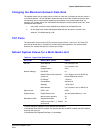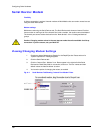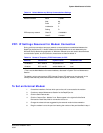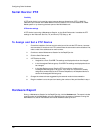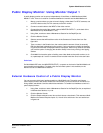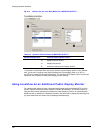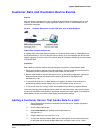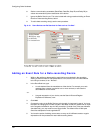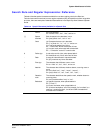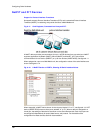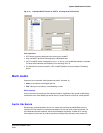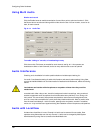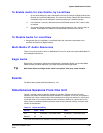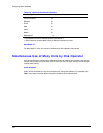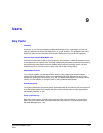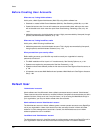
System Administrator’s Guide
Document K14392V1 Rev A 145
07/07
Search Rule and Regular Expressions: Reference
Table 8–6 lists the special characters available for use when making rules in the Rule box.
Technical users who know how to use a regular expression (RE) will benefit most from using table
8–6. Also, there are examples of extended data searches in the Rapid Eye View Software Operator
Guide.
Table 8–6 Special Characters Available for a Search Rule
Character Name Searches for a Match of (…) Within the Rule
. Period Any one character.
Ex: .ire finds “wire”, “tire”, “4ire”, and so on.
[ ] Square
brackets
Each character in the brackets, in turn.
Ex: c[aou]t finds “cat”, “cot” or “cut”.
^ Caret (a) Characters that are not in brackets.
Ex: r[^a] finds “rb”, “rc”, “rA”, “r1” and so on.
(b) A rule at the beginning of a line.
Ex: ^Hume finds “Hume” at the start of lines.
(c) A control code, when used with a backslash.
Ex. \^C finds the “control-C” control code.
$ Dollar sign A rule at the end of a line, when placed after it.
Ex: Kant$ finds only “Kant” at the end of lines.
- Dash A range of characters set in square brackets.
Ex: [a-z] matches any lower case letter.
+ Plus sign The character that it follows, once or more.
Ex: tu+ finds “tu”, “tuu”, “tuuu”, and so on.
* Asterisk The character that it follows, whether absent, occurring once or
more.
Ex: mo*e finds “me”, “moe”, “mooe”, “moooe”, …
Ex: c[au]*t finds “ct”, “cat”, “caat”, “cut”, “cuut”, …
? Question
mark
The character that follows the question mark, whether absent or
occurring once.
Ex: me?y matches either “mey” or “me”.
\ Backslash (a) Special character, when placed before it.
Ex: \? Finds “?”;
(b) Control character, when placed before it.
Ex: \b finds a backspace, \e an Esc (escape), \f a form feed, \n a
new line, \r a carriage return, \t a tab and \x0D a hexadecimal
encoded ASCII character.



